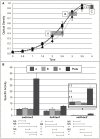MtrR control of a transcriptional regulatory pathway in Neisseria meningitidis that influences expression of a gene (nadA) encoding a vaccine candidate
- PMID: 23409129
- PMCID: PMC3568044
- DOI: 10.1371/journal.pone.0056097
MtrR control of a transcriptional regulatory pathway in Neisseria meningitidis that influences expression of a gene (nadA) encoding a vaccine candidate
Abstract
The surface-exposed NadA adhesin produced by a subset of capsular serogroup B strains of Neisseria meningitidis is currently being considered as a vaccine candidate to prevent invasive disease caused by a hypervirulent lineage of meningococci. Levels of NadA are known to be controlled by both transcriptional regulatory factors and a component of human saliva, 4-hydroxyphenylacetic acid. Herein, we confirmed the capacity of a DNA-binding protein termed FarR to negatively control nadA expression. We also found that a known transcriptional regulator of farR in N. gonorrhoeae termed MtrR can have a negative regulatory impact on farR and nadA expression, especially when over-expressed. MtrR-mediated repression of nadA was found to be direct, and its binding to a target DNA sequence containing the nadA promoter influenced formation and/or stability of FarR::nadA complexes. The complexity of the multi-layered regulation of nadA uncovered during this investigation suggests that N. meningitidis modulates NadA adhesin protein levels for the purpose of interacting with host cells yet avoiding antibody directed against surface exposed epitopes.
Conflict of interest statement
Figures








Similar articles
-
Transcriptional regulation of the nadA gene in Neisseria meningitidis impacts the prediction of coverage of a multicomponent meningococcal serogroup B vaccine.Infect Immun. 2013 Feb;81(2):560-9. doi: 10.1128/IAI.01085-12. Epub 2012 Dec 10. Infect Immun. 2013. PMID: 23230289 Free PMC article.
-
Expression of the meningococcal adhesin NadA is controlled by a transcriptional regulator of the MarR family.Mol Microbiol. 2009 May;72(4):1054-67. doi: 10.1111/j.1365-2958.2009.06710.x. Epub 2009 Apr 21. Mol Microbiol. 2009. PMID: 19400792
-
Structural insight into the mechanism of DNA-binding attenuation of the Neisserial adhesin repressor NadR by the small natural ligand 4-hydroxyphenylacetic acid.Biochemistry. 2012 Aug 28;51(34):6738-52. doi: 10.1021/bi300656w. Epub 2012 Aug 15. Biochemistry. 2012. PMID: 22834735
-
Characterization of FarR as a highly specialized, growth phase-dependent transcriptional regulator in Neisseria meningitidis.Int J Med Microbiol. 2011 Apr;301(4):325-33. doi: 10.1016/j.ijmm.2010.11.007. Epub 2011 Feb 2. Int J Med Microbiol. 2011. PMID: 21292554
-
Role of factor H binding protein in Neisseria meningitidis virulence and its potential as a vaccine candidate to broadly protect against meningococcal disease.Microbiol Mol Biol Rev. 2013 Jun;77(2):234-52. doi: 10.1128/MMBR.00056-12. Microbiol Mol Biol Rev. 2013. PMID: 23699256 Free PMC article. Review.
Cited by
-
4-hydroxyphenylacetic acid attenuated inflammation and edema via suppressing HIF-1α in seawater aspiration-induced lung injury in rats.Int J Mol Sci. 2014 Jul 21;15(7):12861-84. doi: 10.3390/ijms150712861. Int J Mol Sci. 2014. PMID: 25050781 Free PMC article.
-
Neisseria adhesin A variation and revised nomenclature scheme.Clin Vaccine Immunol. 2014 Jul;21(7):966-71. doi: 10.1128/CVI.00825-13. Epub 2014 May 7. Clin Vaccine Immunol. 2014. PMID: 24807056 Free PMC article.
-
The Host-Pathogen Interactions and Epicellular Lifestyle of Neisseria meningitidis.Front Cell Infect Microbiol. 2022 Apr 22;12:862935. doi: 10.3389/fcimb.2022.862935. eCollection 2022. Front Cell Infect Microbiol. 2022. PMID: 35531336 Free PMC article. Review.
-
An international invasive meningococcal disease outbreak due to a novel and rapidly expanding serogroup W strain, Scotland and Sweden, July to August 2015.Euro Surveill. 2016 Nov 10;21(45):30395. doi: 10.2807/1560-7917.ES.2016.21.45.30395. Euro Surveill. 2016. PMID: 27918265 Free PMC article.
-
Molecular Basis of Ligand-Dependent Regulation of NadR, the Transcriptional Repressor of Meningococcal Virulence Factor NadA.PLoS Pathog. 2016 Apr 22;12(4):e1005557. doi: 10.1371/journal.ppat.1005557. eCollection 2016 Apr. PLoS Pathog. 2016. PMID: 27105075 Free PMC article.
References
-
- Stephens DS, Greenwood B, Brandtzaeg P (2007) Epidemic meningitis, meningococcaemia, and Neisseria meningitidis . Lancet 369: 2196–2210. - PubMed
-
- Sharip A, Sorvillo F, Redelings MD, Mascola L, Wise M, et al. (2006) Population-based analysis of meningococcal disease mortality in the United States: 1990–2002. Pediatr Infect Dis J 25: 191–194. - PubMed
-
- Cartwright KA (1995) Meningococcal Carriage and Disease. In: Cartwright KA, editor. Meningococcal Disease. Chichester: John Wiley & Sons. pp. 115–146.
-
- Virji M (2009) Pathogenic neisseriae: surface modulation, pathogenesis and infection control. Nat Rev Microbiol 7: 274–286. - PubMed
Publication types
MeSH terms
Substances
Grants and funding
LinkOut - more resources
Full Text Sources
Other Literature Sources

